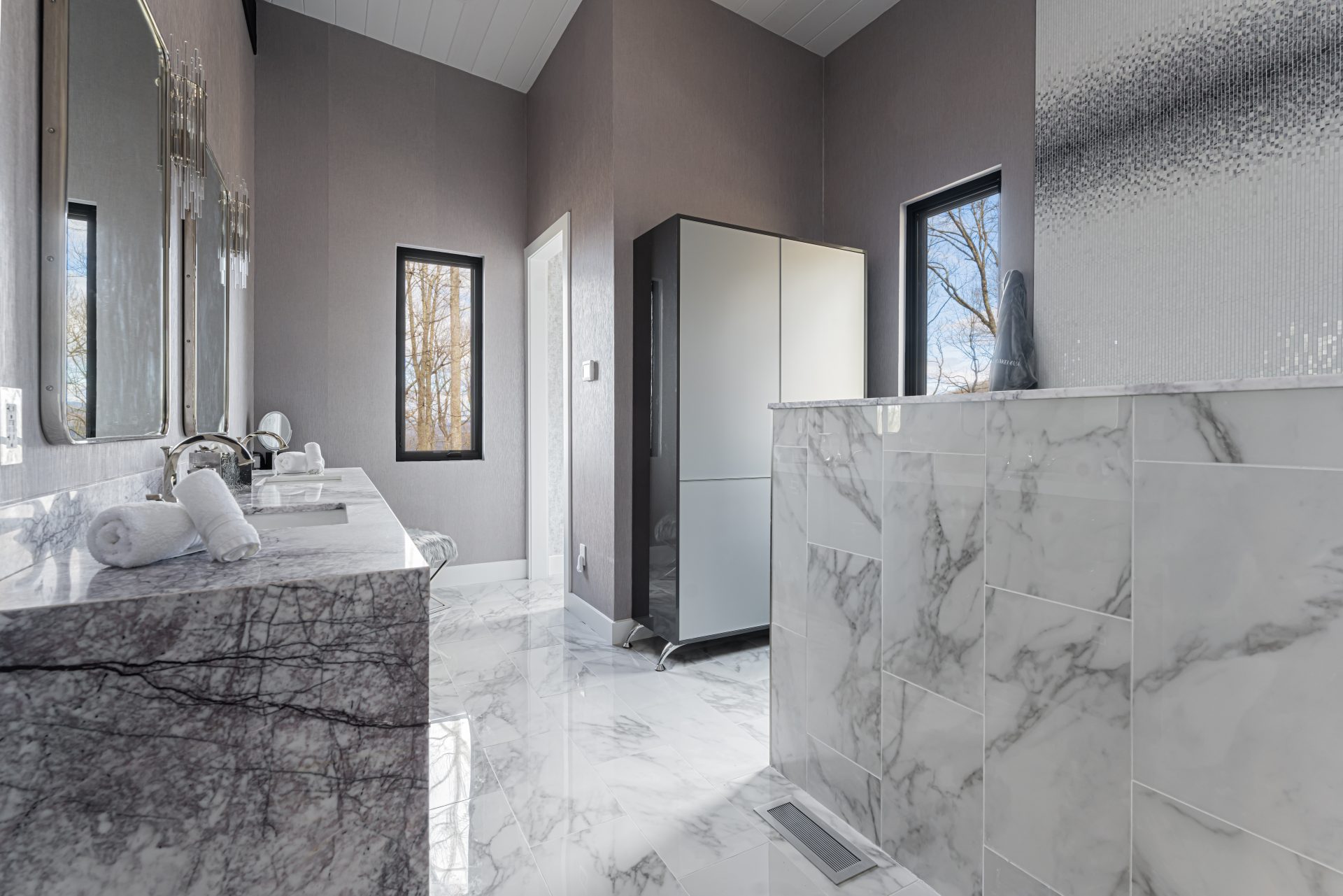Learn about this luxurious design strategy, perfect for timber frame houses.

This bathroom in a custom Woodhouse home makes elegant use of waterproof surfaces, which, in some areas, stretch from the floor to the ceiling.
Bathrooms are one of the home’s most personal spaces, and their design plays an outsized role in your daily life. Therefore, they should be as customized and luxurious as the rest of your bespoke home. Wet rooms are one way homeowners are achieving this next-level luxury. Whether partially or fully waterproofed, this approach to bathroom design has been popular throughout Scandinavia and Asia for decades; however, recently, they have been gaining traction in the U.S. for a variety of reasons.
Keep reading to learn more about these high-function, high-fashion spaces and if a wet room is the right upgrade for your dream home.

Note how the seamless floor makes navigation a breeze — a feature particularly optimal for aging in place.
What is a Wet Room?
A wet room is a special type of bathroom design where either 1) the entire room is waterproofed, or 2), the tub and shower are partitioned into their own “room” within the bathroom. Because the room, or at least most of it, is waterproof, there is no need for a traditional shower or shower/tub enclosure. Instead of a basin, the shower floor is continuous and almost level with the rest of the floor, except for a slight slope to channel water to the drain.
In timber frame houses, the great room is an open-concept design where the kitchen, dining, and living room share an expansive space. Wet rooms are the bathroom equivalent. The shower and tub share one zone, while the toilet and sink might occupy another. Some designs may include a partial wall demarcating the shower for privacy and aesthetics.
If you’re not ready to go all-in, take a cue from some homeowners who opt for a hybrid design, covering most surfaces in tile and waterproof materials, while still creating some sense of designated space. Take for example this sleek bathroom (pictured below) in a custom Woodhouse timber frame, which tucks the shower behind glass and a tiled half wall.
Wet Rooms vs. Bathrooms
Typically, all wet rooms are bathrooms, but not all bathrooms are wet rooms. Several distinctions will tell you that you’ve stepped into a wet room. In a wet room, all surfaces including walls, floors, and ceilings are sealed against water infiltration. Low porosity, porcelain tiles and natural stone are all good candidates to safeguard against moisture damage.
Traditional bathroom showers typically have a raised tray or basin and walls to contain the water, with a drain set in the middle. Wet room drains are installed directly into the floor, which can be offset from the shower area. Unlike a conventional bathroom which makes use of barriers to partition various bathroom functions, like the shower, toilet, and vanity, a wet room typically has minimal or no such enclosures.
Advantages of a Wet Room
While the wet room trend is just getting started in the U.S., other parts of the world have long since recognized the many benefits associated with this design. Benefits include:
- Easy to clean. Continuous, waterproof surfaces make for a sanitary space that’s easy to clean and maintain.
- Universal design. With level floors and lack of enclosures, wet rooms are accessible for those who need ambulatory assistance such as walkers and wheelchairs.
- Spaciousness. The natural, minimalist design of wet rooms makes even smaller bathrooms feel more open, brighter, and fresher.
Wet Rooms in Timber Frame Houses
Timber frame houses are already well-suited for luxury bathrooms and a wet room only dials up the appeal. There are a plethora of Woodhouse timber frame home styles and each can be tailored to your idea of timber frame house perfection. This flexibility extends to a wet room, transforming an everyday space into an oasis for rejuvenation or relaxation.
Your Dream Bathroom Starts Here
From efficient escapes to a spacious spa, find inspiration in our online gallery for the bathroom of your dreams. Then, contact us for an introduction and conversation.





